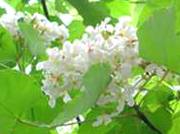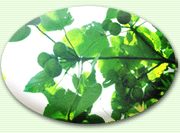Related
Products
Tung Oil
 Tung oil tree (Aleurites
fordii), a deciduous shade tree native to China. It belongs to the Euphorbia
Family (Euphorbiaceae) along with the candlenut tree (A molucanna), another
species with seeds rich in unsaturated oils. For centuries tung oil has been
used for paints and waterproof coatings, and as a component of caulk and
mortar. It is an ingredient in ink and is commonly used for a lustrous finish
on wood. Some woodworkers consider tung oil to be one of the best natural
finishes for wood.
Tung oil tree (Aleurites
fordii), a deciduous shade tree native to China. It belongs to the Euphorbia
Family (Euphorbiaceae) along with the candlenut tree (A molucanna), another
species with seeds rich in unsaturated oils. For centuries tung oil has been
used for paints and waterproof coatings, and as a component of caulk and
mortar. It is an ingredient in ink and is commonly used for a lustrous finish
on wood. Some woodworkers consider tung oil to be one of the best natural
finishes for wood.
 Tung oil tree showing two
male flowers and one female flower (right) in which the petals have fallen off
exposing the pistil.
Tung oil tree showing two
male flowers and one female flower (right) in which the petals have fallen off
exposing the pistil.
Other unsaturated plant oils, such as castor oil and linseed oil, take longer to
dry and leave an oily residue until they soak into the wood surface. Tung oil 's
ability to dry quickly and polymerize into a tough, glossy, waterproof coating
has made it especially valuable in paints, varnishes, linoleum, oilcloth and
printing inks.
 Drupaceous fruit and seeds
of the tung oil tree. The oil-rich seeds
Drupaceous fruit and seeds
of the tung oil tree. The oil-rich seeds
are produced inside a thick, woody endocarp layer and are the
source of tung oil used on fine furniture.
The pit of a peach (Prunus persica) showing the seed that is contained inside
the hard, woody endocarp layer. The endocarp is
the inner layer of the fruit wall or pericarp. It is surrounded by a
fleshy mesocarp and a thin outer skin or exocarp. Fruits with an endocarp layer
surrounding the seed are called drupes or drupaceous. The endocarp protects and
aids in the dispersal of the vulnerable seed, especially when it is swallowed by
a hungry herbivore.
HISTORY:
Pure Tung Oil is a finishing product that provides a tough, flexible and highly water-resistant coating. It is classed as a drying oil along with linseed, poppy seed, safflower seed, walnut, soybean, oiticica and a few other oils. Although it is relatively new to the Western world, tung oil has been known for centuries to the Chinese, and until this century, China was the main source for the oil. It comes from the seed of the tung trees, Aleurites fordii and Aleurites montana, deciduous trees that are very susceptible to frost damage. This vulnerability has restricted the cultivation of the tung trees to China and South America. Tung oil received wide application in China: in the building trades as a treatment for both stone and wooden structures; in marine trades as a preservative and water repellant on wooden boats. It is said to have been introduced to the West by Marco Polo. From the 13th to the 19th century, tung oil had only limited use in the West. In the 19th century it was adopted by the paint companies to become a major component in paints and varnishes. More recently, tung oil has gained favor over linseed oil for furniture finishing because it is faster drying and does not darken as much with age.
PROPERTIES AND CHARACTERISTICS:
Pure Tung Oil is water and alkali resistant. It resists marring, penetrates well, is elastic and unlikely to check. Tung oil builds quickly, consolidates the wood surface and builds a transparent matte finish. It should be kept in an airtight container with minimum air space. Pure Tung Oil contains no thinners or driers and has a light nutty odor.
Tung oil is composed primarily of eleostearic (elaeostearic)
acid, with smaller amounts of oleic, linoleic and palmitic glycerides.
Eleostearic acid is a crystalline unsaturated fatty acid that exists in 2
stereoisomeric forms: An alpha acid occurring as the glycerol ester especially
in tung oil, and a beta acid obtained from the alpha acid by irradiation (9,
11, 13-octadecatrienoic acid). The chemical structure of tung oil eleostearic
acid:
CH3(CH2)3CH=CHCH=CHCH=CH(CH2)7COOH
APPLICATION:
The surface should be dusted to remove all loose particles.
Alternatively, you can lightly sand the first coat before applying a second. Any
filling, sealing or staining must be done before the oil is applied. The first
coat should be a liberal one, and you can rub it over the wood with your hand, a
soft rag. Allow this application to sit for 5-10 minutes so the oil can soak in,
then remove any excess with clean soft rags. Check after about half an hour for
any seeping, and rub this off as well. Let dry completely (24-48 hours) between
coats. For woods with very open pores, allow an extra 24 hours drying time.
Tung oil can be applied pure (without additives) if a non-toxic finish is
required. If this is not necessary, you can accelerate the drying process and
greatly improve the penetration by cutting the first coat of oil with mineral
spirits or turpentine by 50%. Remember, Pure Tung Oil becomes toxic with these
substances mixed into it, although the finish produced is not toxic because the
driers evaporate.
The number of coats of oil to be applied will be determined by the intended use
of the piece. Two to four coats are enough for decorative work, paneling and
molding. Surfaces that receive moderate use or handling will need about six
coats. Heavily used surfaces, such as table tops, should be given ten or more
coats for maximum protection, plus a light renewal coat a couple of times a
year. Renewal and building coats are quickly applied with cheese cloth, a lint
free cloth or old nylon stockings. This process will give you a surface that
will stand up to vigorous use and spills: water will bead on the surface.
Pure Tung Oil is recommended for kitchen tables, chopping blocks and boards, and
similar uses. Its non-toxic nature makes it particularly appropriate for
children's toys and furniture. It gives good protection to wood paneling and
molding.
Pure Tung Oil's matte finish will do nicely on certain pieces of furniture, but
if a glossy finish is preferred you will need to buff and wax the finish, or use
polymerized tung oil or a formulated tung oil based product.
We have found tung oil to be a valuable helper in the workshop. It adheres very
well to metal, and a light coat rubbed onto tool steel is an effective rust
inhibitor. Wooden handles will also benefit from the occasional coat.
TUNG OIL VERSUS OTHER FINISHES
In recent years, those who appreciate the warm richness of beautiful wood have begun to realize what the ancient Chinese knew; when turned into a finishing product, Tung Oil is the finest natural wood finish in existence and has yet to be duplicated synthetically!
Man's ingenuity has created many synthetic finishes, including lacquer, shellac, and varnish all of which protect wood with a hard impervious layer. But these surface finishes prevent the development of patina, the lovely depth and tone that only natural aging can produce. Eventually synthetic finishes will break down and discolor, when that happens the entire surface must be removed by labor intensive stripping and sanding before another coat is applied.
Penetrating finishes formulated with linseed, soy or paraffin oils actually go into the wood and enhance its natural beauty, but these oils often dry incompletely and fail to form a hard and durable surface. Furthermore, they develop a gummy build-up when additional coats are applied. Linseed oil, the most commonly used penetrating finish, darkens and changes color with time and finally disintegrates.
A Polymerized Tung Oil finish is hard yet flexible, waterproof and impervious to alcohol and many food acids. Polymerized Tung oil as a penetrating oil allows wood to continue its aging process and to develop its patina. The wood's rich color and grain are enhanced by the natural ambering (coloring) of Polymerized Tung oil over time. Any sign of wear disappears when a thin "maintenance" coat of oil is rubbed in. The maintenance coats, rather than cause a build-up, actually improve the patina as they protect and preserve the wood. A floor, a piece of furniture, or any other wood object finished and maintained with Polymerized Tung Oil will never have to be stripped again. The finish will become more beautiful with time.
POLYMERIZATION AND FORMULATION
As Tung Oil dries and cures, the molecules join together in a tight complex formation. This process is the secret to Tung Oil's effectiveness as a finish. The cross linking of the oil's molecules makes the surface waterproof and impervious to many chemicals. The bonding also gives flexibility to the surface, making it capable of withstanding wear and tear.





